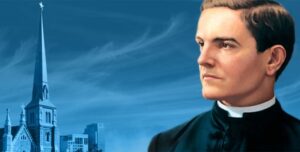Our Council History

On May 13, 1956, the Supreme Council Knights of Columbus of New Haven, Connecticut, granted a charter to Manordale Valley Council No. 4226, signed by Supreme Knight Luke Hart. Sixty (60) Catholic men from the Manordale Valley – comprising Murrysville, Export, Delmont and Slickville and vicinity – have their names enrolled on this charter to their perpetual honor and memory.
The first Grand Knight of the Council was William Dougherty who served three terms. Meetings of the council in those early years were held in St. Mary church in Export, moving to St. John in Delmont in 1961 and back to St. Mary in 1962. The Council purchased their first and only home, the original Mother of Sorrows Church, from the Greensburg Diocese in 1963. The first meeting of Council 4226 in their new home was July 21,1963.
The first year found the Knights and their ladies a most effective group holding a Memorial Service, a Christmas Dinner, and a New Year’s Eve Party before the year was out. The first council picnic was held on the council grounds the next summer. The 500 Club, which had been established in 1962 to raise the funds needed to purchase this home, was quite successful; the home was paid off and the mortgage was burned in April 1966. The 500 Club, dissolved in 1965, was re-activated in 1966 to raise the funds needed to fix up the building and keep the Home Association solvent.
Knights of Columbus History
Knights of Columbus - Our History
Michael J. McGivney, an American Catholic priest, founded the Knights of Columbus in New Haven, Connecticut. He gathered a group of men from St. Mary's Parish for an organizational meeting on October 2, 1881. It was incorporated on March 29, 1882. McGivney had originally conceived of the name "Sons of Columbus". James T. Mullen, who later led the organization, coined the name "Knights of Columbus", which expressed the ritualistic nature of the new organization and drew from positive historical associations.[1]
The Order was intended to be a mutual benefit society. As a parish priest in an immigrant community, McGivney saw what could happen to a family when the main income earner died. This was before most government support programs were established. He wanted to provide insurance to care for the widows and orphans left behind. In his own life, he temporarily had to suspend his seminary studies to care for his family after his father died.[2]

Because of religious and ethnic discrimination, Roman Catholics in the late 19th century were regularly excluded from labor unions, popular fraternal organizations, and other organized groups that provided such social services.[3] Papal encyclicals issued by the Holy See also prohibited Catholics from participating as lodge members within Freemasonry. McGivney intended to create an alternative organization. He also believed that Catholicism and fraternalism were compatible and wanted to found a society to encourage men to be proud of their American–Catholic heritage.[4]
Fraternal organizations, which combined social aspects and ritual, were especially flourishing during the latter third of the nineteenth century, the so-called "Golden Age of Fraternalism.[5] New Haven's Irish Catholic men of the era could have joined one of many other organizations,[a] and Catholics of other ethnicities had additional options.[6]
McGivney traveled to Boston to examine the Massachusetts Catholic Order of Foresters and to Brooklyn, New York to learn about the recently established Catholic Benevolent League, both of which offered insurance benefits. He found the latter to be lacking the excitement he thought was needed if his organization were to compete with the secret societies of the day. He explored establishing a New Haven Court of the Foresters, but the group's charter in Massachusetts limited them to operating within that Commonwealth. McGivney's committee of St. Mary's parishioners decided to form a new club.[7]
